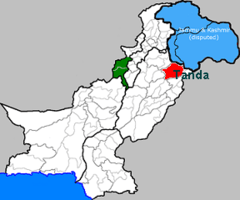Tanda (Gujrat)
| Tanda Mota | |
|---|---|
 | |
| Coordinates: 32°42′07″N 74°22′05″E / 32.702°N 74.368°ECoordinates: 32°42′07″N 74°22′05″E / 32.702°N 74.368°E | |
| Country |
|
| Area | |
| • Total | 5 km2 (2 sq mi) |
| Population | |
| • Total | 100,000 |
| Time zone | PST (UTC+5) |
| Calling code | 053 |
Tanda is a town in Gujrat District in the Pakistani province of Punjab. It is a Union council, an administrative subdivision of Gujrat Tehsil.[1]
History
The word Tanda means "traveling body or gangs" in the Labanki language. Before the Partition of Punjab in 1947 the town had a large population of Sikhs belonging to the Labana community. Labanas were brought in by Choudhery of Mota (an adjacent village) to protect them from the gangs of thieves use to come down from Kashmir mountain mostly from Village Naryana of Jammu & Kashmir to loot the villagers. After partition they migrated to East Punjab, conversely Gujjar tribes from Jammu & Kashmir migrated into the Tanda area at the same time. Labanas established a community school in Tanda for the free education of their community, for this cause their tribe decided that no women will wear jewelry and all held should be deposited for the establishment of school. This school with boarding house very quickly established its repo and even before partition considered one of the best schools in the zone.
Geography
Tanda is located at 32°42′07″N 74°22′05″E / 32.702°N 74.368°E. Tanda is the name of a small locality, which is a well-known small city of Gujrat. A village located 5 km near Tanda named Barila Sharif. That village is famous for saint and graves; there was a famous grave of Hazrat Qanbeet A.S that is 70 yards long. All over the Punjab people visited that place.
Climate
The city has moderate climate. During the peak of summer, the daytime temperature shoots up to 45 °C, but the hot spells are relatively short due to the proximity of the Azad Kashmir Mountains. During the winter, the minimum temperature may fall below 2 °C. The average rainfall is 67 cm.
Demography
Most people in the town speak Gojri, though almost all of them can also speak Punjabi. Urdu and English is also spoken by the educated elite.
Education
The higher secondary school in the town, Government Higher Secondary School, has nurtured many brilliant students over the years which have gone to make a name in larger Pakistani cities and overseas. Nadeem Qaiser is one of them who has acquired a PhD degree from KAIST (a highly ranked Korean University) followed by Engineering degree from UET Taxila. It was established in 1820.